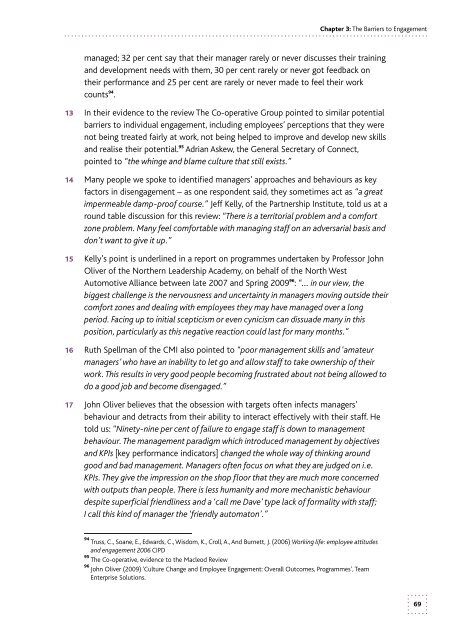3ytgeaf
3ytgeaf
3ytgeaf
You also want an ePaper? Increase the reach of your titles
YUMPU automatically turns print PDFs into web optimized ePapers that Google loves.
Chapter 3: The Barriers to Engagement<br />
managed; 32 per cent say that their manager rarely or never discusses their training<br />
and development needs with them, 30 per cent rarely or never got feedback on<br />
their performance and 25 per cent are rarely or never made to feel their work<br />
counts 94 .<br />
13 In their evidence to the review The Co-operative Group pointed to similar potential<br />
barriers to individual engagement, including employees’ perceptions that they were<br />
not being treated fairly at work, not being helped to improve and develop new skills<br />
and realise their potential. 95 Adrian Askew, the General Secretary of Connect,<br />
pointed to “the whinge and blame culture that still exists.”<br />
14 Many people we spoke to identified managers’ approaches and behaviours as key<br />
factors in disengagement – as one respondent said, they sometimes act as “a great<br />
impermeable damp-proof course.” Jeff Kelly, of the Partnership Institute, told us at a<br />
round table discussion for this review: “There is a territorial problem and a comfort<br />
zone problem. Many feel comfortable with managing staff on an adversarial basis and<br />
don’t want to give it up.”<br />
15 Kelly’s point is underlined in a report on programmes undertaken by Professor John<br />
Oliver of the Northern Leadership Academy, on behalf of the North West<br />
Automotive Alliance between late 2007 and Spring 2009 96 : “… in our view, the<br />
biggest challenge is the nervousness and uncertainty in managers moving outside their<br />
comfort zones and dealing with employees they may have managed over a long<br />
period. Facing up to initial scepticism or even cynicism can dissuade many in this<br />
position, particularly as this negative reaction could last for many months.”<br />
16 Ruth Spellman of the CMI also pointed to “poor management skills and ‘amateur<br />
managers’ who have an inability to let go and allow staff to take ownership of their<br />
work. This results in very good people becoming frustrated about not being allowed to<br />
do a good job and become disengaged.”<br />
17 John Oliver believes that the obsession with targets often infects managers’<br />
behaviour and detracts from their ability to interact effectively with their staff. He<br />
told us: “Ninety-nine per cent of failure to engage staff is down to management<br />
behaviour. The management paradigm which introduced management by objectives<br />
and KPIs [key performance indicators] changed the whole way of thinking around<br />
good and bad management. Managers often focus on what they are judged on i.e.<br />
KPIs. They give the impression on the shop floor that they are much more concerned<br />
with outputs than people. There is less humanity and more mechanistic behaviour<br />
despite superficial friendliness and a ‘call me Dave’ type lack of formality with staff;<br />
I call this kind of manager the ‘friendly automaton’.”<br />
94<br />
Truss, C., Soane, E., Edwards, C., Wisdom, K., Croll, A., And Burnett, J. (2006) Working life: employee attitudes<br />
and engagement 2006 CIPD<br />
95<br />
The Co-operative, evidence to the Macleod Review<br />
96<br />
John Oliver (2009) ‘Culture Change and Employee Engagement: Overall Outcomes, Programmes’, Team<br />
Enterprise Solutions.<br />
69


